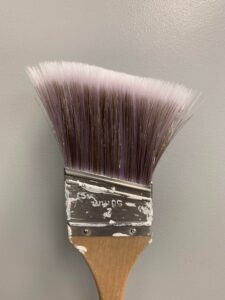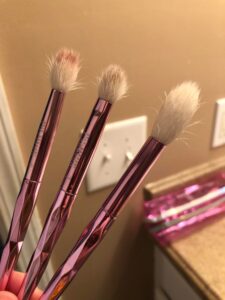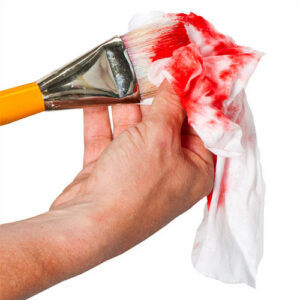Enamel paint is a high-quality paint that is known for its durability and long-lasting finish. However, cleaning enamel paint off of a brush can be a challenging task, as the paint tends to dry quickly and can be difficult to remove.
By following these guidelines, you can effectively remove dried enamel paint from your brushes and keep them in good condition for future use.
How to clean enamel paint from a paint brush
Cleaning enamel paint from a brush can be a challenging task, as the paint tends to dry quickly and can be difficult to remove. If not cleaned properly, a brush that has been used to apply enamel paint can become stiff and unusable. However, by following a few simple steps, you can effectively remove dried enamel paint from your brushes and keep them in good condition for future use.
Here’s how to clean enamel paint from a brush:
- Begin by scraping off as much of the dried paint as possible using a scraper or putty knife. This will help to loosen the paint and make it easier to remove.
- Next, fill a jar or container with mineral spirits or paint thinner. Soak the brush in the solvent for a few hours to soften the paint.
- After a few hours, use a wire brush or scrub pad to scrub the bristles of the brush to remove any remaining paint.
- Rinse the brush thoroughly with water to remove any solvent or paint residue.
- Use a mild soap, such as dish soap, to wash the brush. Lather the bristles and rinse thoroughly with water.
- Repeat the above steps as needed until the brush is completely clean.
- Finally, reshape the bristles and allow the brush to air dry.
By following these steps, you can effectively clean enamel paint from a brush and extend the life of your painting tools. It is important to use caution when working with solvents, as they can be harmful to your skin and eyes. Be sure to wear gloves and protective eyewear when cleaning enamel paint from a brush.
What is the best cleaner for enamel paint?
There are several cleaners that can be effective at removing enamel paint, including:
- Mineral spirits: Mineral spirits, also known as white spirit or turpentine substitute, is a solvent that can be used to remove enamel paint from surfaces and tools. It is generally less harsh than turpentine and has a lower odor.
- Acetone: Acetone is a strong solvent that can be effective at removing enamel paint from a variety of surfaces. It is commonly found in nail polish remover and is also available in pure form.
- Paint thinner: Paint thinner is a solvent that is specifically formulated to remove paint. It can be effective at removing enamel paint from surfaces and tools.
- Denatured alcohol: Denatured alcohol is a solvent that can be used to remove enamel paint from surfaces. It evaporates quickly and does not leave a residue.
It is important to use caution when working with solvents, as they can be harmful to your skin and eyes. Be sure to wear gloves and protective eyewear when using these cleaners and follow the manufacturer’s instructions for safe use. It is also generally best to test the cleaner in a small, inconspicuous area first to ensure that it does not damage the surface.
Can you use acetone to clean enamel paint brushes?
Yes, acetone can be used to clean enamel paint brushes. Acetone is a strong solvent that is effective at dissolving and removing enamel paint from brushes and other surfaces. To use acetone to clean an enamel paint brush, follow these steps:
- Begin by scraping off as much of the dried paint as possible using a scraper or putty knife. This will help to loosen the paint and make it easier to remove.
- Next, pour a small amount of acetone into a container and soak the brush in the solvent for a few hours to soften the paint.
- After a few hours, use a wire brush or scrub pad to scrub the bristles of the brush to remove any remaining paint.
- Rinse the brush thoroughly with water to remove any acetone or paint residue.
- Use a mild soap, such as dish soap, to wash the brush. Lather the bristles and rinse thoroughly with water.
- Repeat the above steps as needed until the brush is completely clean.
- Finally, reshape the bristles and allow the brush to air dry.
It is important to use caution when working with acetone, as it can be harmful to your skin and eyes. Be sure to wear gloves and protective eyewear when cleaning enamel paint from a brush with acetone. In addition, be sure to follow the manufacturer’s instructions for safe use and dispose of acetone responsibly.
Does rubbing alcohol ruin paint brushes?
Rubbing alcohol, also known as isopropyl alcohol, can be used to clean paint brushes, but it can also damage the bristles if not used properly. Rubbing alcohol is a solvent that can dissolve paint and remove it from brushes, but it can also cause the bristles to become stiff and brittle if left on the brush for an extended period of time.
To use rubbing alcohol to clean a paint brush, follow these steps:
- Begin by scraping off as much of the dried paint as possible using a scraper or putty knife. This will help to loosen the paint and make it easier to remove.
- Next, pour a small amount of rubbing alcohol into a container and soak the brush in the solvent for a few minutes to soften the paint.
- After a few minutes, use a wire brush or scrub pad to scrub the bristles of the brush to remove any remaining paint.
- Rinse the brush thoroughly with water to remove any rubbing alcohol or paint residue.
- Use a mild soap, such as dish soap, to wash the brush. Lather the bristles and rinse thoroughly with water.
- Repeat the above steps as needed until the brush is completely clean.
- Finally, reshape the bristles and allow the brush to air dry.
It is important to use caution when working with rubbing alcohol, as it can be harmful to your skin and eyes. Be sure to wear gloves and protective eyewear when cleaning
Can you use vinegar on enamel paint on brushes?
Vinegar can be used to clean enamel paint from brushes, but it may not be as effective as some other cleaners. Vinegar is a mild acid that can help to dissolve paint, but it may not be strong enough to remove dried enamel paint from brushes.
To use vinegar to clean an enamel paint brush, follow these steps:
- Begin by scraping off as much of the dried paint as possible using a scraper or putty knife. This will help to loosen the paint and make it easier to remove.
- Next, mix equal parts vinegar and water in a container. Soak the brush in the mixture for a few hours to soften the paint.
- After a few hours, use a wire brush or scrub pad to scrub the bristles of the brush to remove any remaining paint.
- Rinse the brush thoroughly with water to remove any vinegar or paint residue.
- Use a mild soap, such as dish soap, to wash the brush. Lather the bristles and rinse thoroughly with water.
- Repeat the above steps as needed until the brush is completely clean.
- Finally, reshape the bristles and allow the brush to air dry.
If vinegar does not effectively remove the enamel paint from the brush, you may need to use a stronger cleaner such as mineral spirits or acetone. Be sure to use caution when working with these cleaners, as they can be harmful to your skin and eyes. Wear gloves and protective eyewear and follow the manufacturer’s instructions for safe use.
What do painters use to clean paint brushes?
Painters typically use solvents to clean paint brushes. Solvents are chemicals that can dissolve paint and remove it from brushes and other surfaces. Some common solvents used by painters to clean paint brushes include:
- Mineral spirits: Mineral spirits, also known as white spirit or turpentine substitute, is a solvent that can be used to remove paint from brushes and other surfaces. It is generally less harsh than turpentine and has a lower odor.
- Acetone: Acetone is a strong solvent that can be effective at removing paint from a variety of surfaces. It is commonly found in nail polish remover and is also available in pure form.
- Paint thinner: Paint thinner is a solvent that is specifically formulated to remove paint. It can be effective at removing paint from brushes and other tools.
- Denatured alcohol: Denatured alcohol is a solvent that can be used to remove paint from surfaces. It evaporates quickly and does not leave a residue.
In addition to using solvents, painters may also use soap and water to clean paint brushes. Mild soap, such as dish soap, can help to remove paint and dirt from the bristles of the brush.
It is important to use caution when working with solvents, as they can be harmful to your skin and eyes. Be sure to wear gloves and protective eyewear when using these cleaners and follow the manufacturer’s instructions for safe use. It is also generally best to test the cleaner in a small, inconspicuous area first to ensure that it does not damage the surface.
Is enamel paint soluble in water?
Enamel paint is generally not soluble in water. Enamel paint is a type of paint that is known for its durability and long-lasting finish. It is made with a oil- or alkyd-based resin and is typically applied to surfaces using a brush or roller.
One of the characteristics of enamel paint is that it is resistant to water and does not dissolve in water. This makes it a popular choice for use on surfaces that are prone to moisture, such as bathrooms and kitchens.
However, while enamel paint itself is not soluble in water, some enamel paints may contain water-soluble resins or other ingredients that can be dissolved in water. These types of enamel paints may be easier to clean up with water, but they may not have the same level of durability as traditional enamel paints.
It is important to read the label on the enamel paint to determine the best way to clean up spills and splatters. In general, it is best to use a solvent such as mineral spirits or paint thinner to remove enamel paint from surfaces and tools. Be sure to use caution when working with solvents, as they can be harmful to your skin and eyes. Wear gloves and protective eyewear and follow the manufacturer’s instructions for safe use.
Wrapping Up
In conclusion, cleaning enamel paint from a brush can be a challenging task, as the paint tends to dry quickly and can be difficult to remove. However, by following a few simple steps, you can effectively remove dried enamel paint from your brushes and keep them in good condition for future use.
It is important to use caution when working with solvents, as they can be harmful to your skin and eyes. Be sure to wear gloves and protective eyewear when cleaning enamel paint from a brush and follow the manufacturer’s instructions for safe use.
Other cleaning guides
How To Clean A Hairbrush Lint (Very Easy Method)
How To Clean Woodland Shoes (Make Them New Again)




